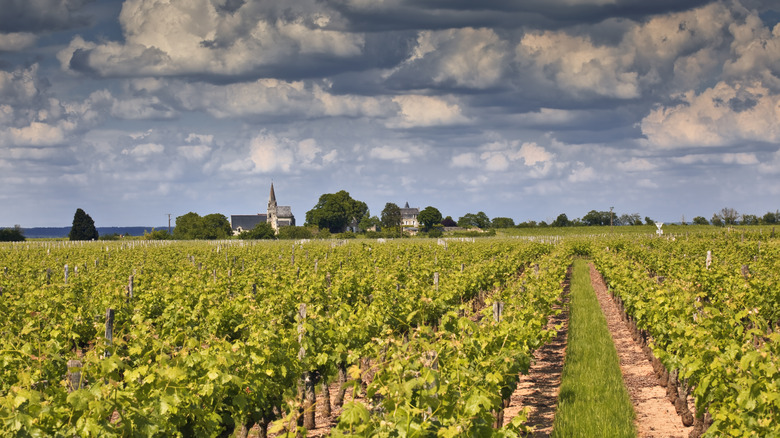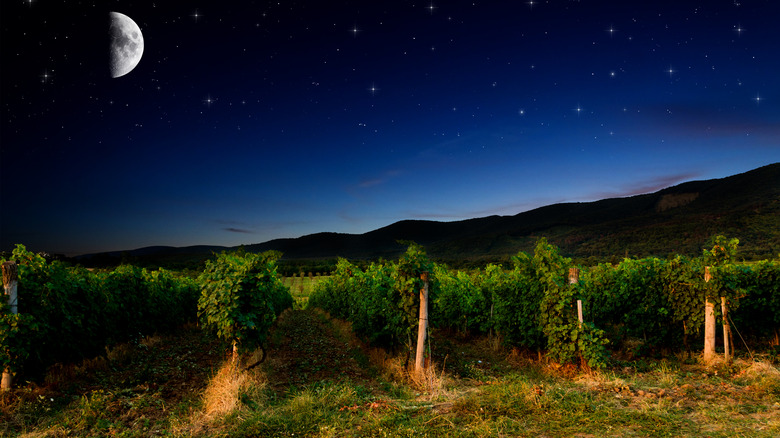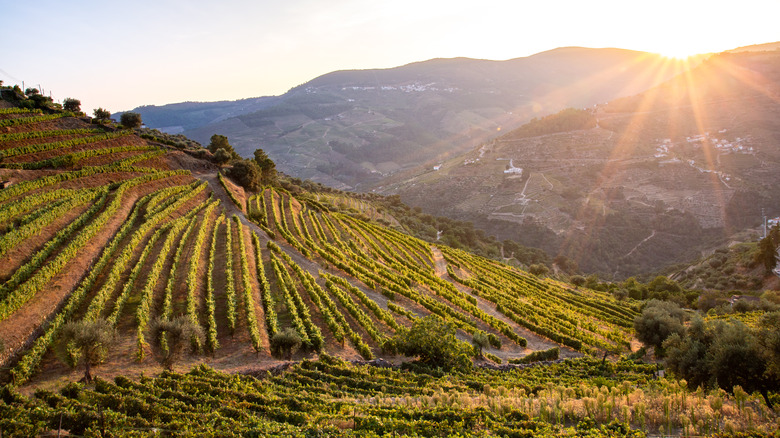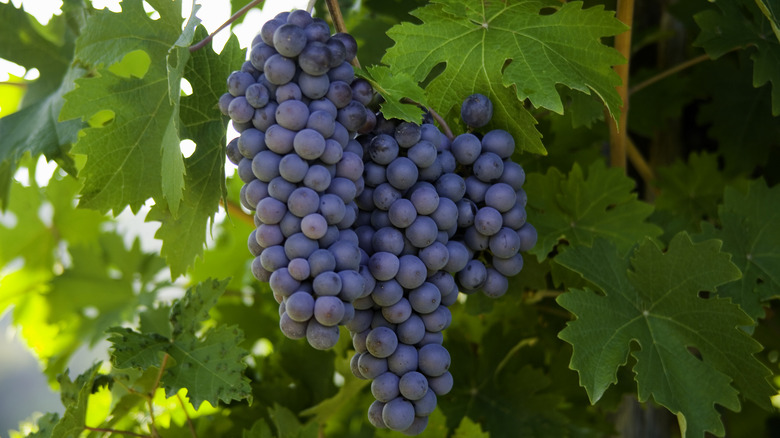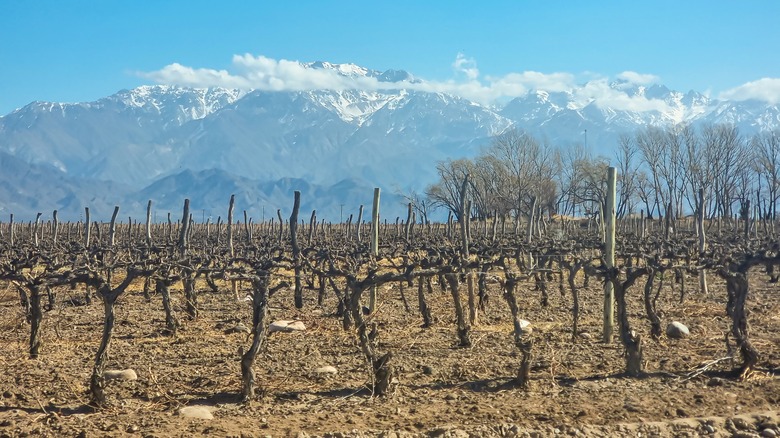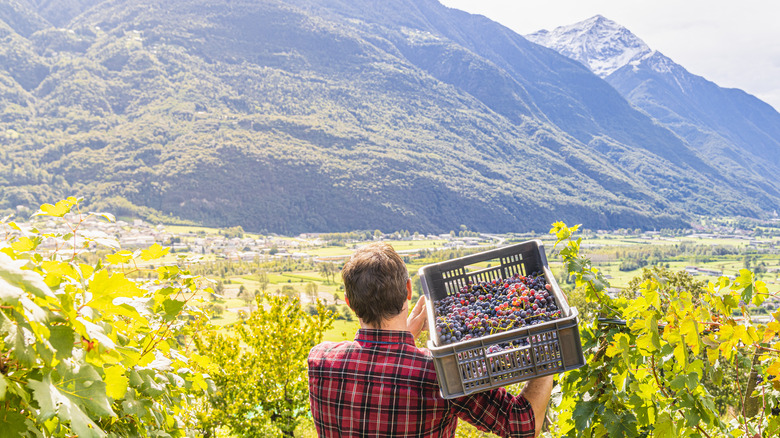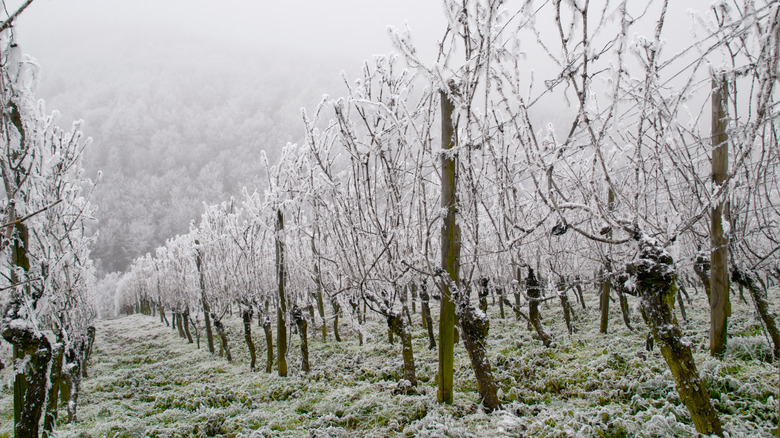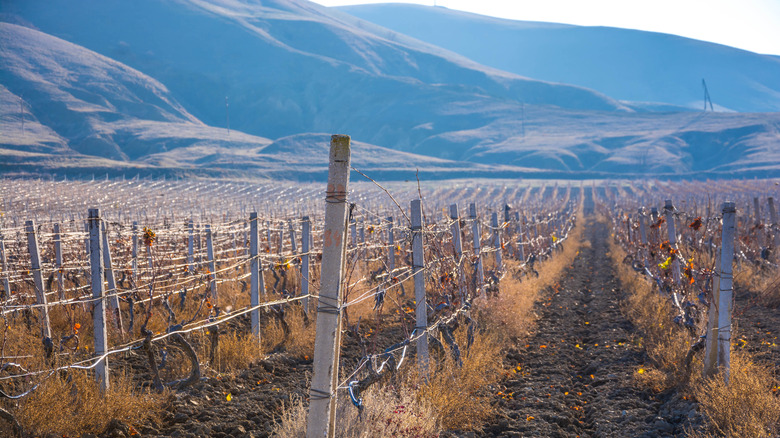Why High Altitude Wine Tastes So Different Compared To Standard Wine
Buying wine can be a confusing experience if you haven't gone deep down the rabbit hole. While basic details like vineyard region, vintage, and grape variety are often displayed on the label, other properties and qualifications might be less common to include. In some cases, you'll find bottle stickers detailing facts about the altitude of the vineyards, proudly boasting numbers significantly above sea level.
There are many ways to categorize wine, and one is to look at vineyard altitude. Depending on the region, high altitude vineyards are typically defined as being over 1,000 feet (though above 1,600 feet is a standard in other regions, per the Center for Research, Environmental Sustainability and Advancement of Mountain Viticulture). Whereas this is quite high in some areas close to the sea, in places like the Andes mountains, the numbers dramatically increase.
Flatter regions at lower altitudes have a certain set of attributes that are quite distinct from those of vineyards at a higher altitude. Factors like sunshine, temperature, soil, and more, affect the way that grapes grow in a vineyard. Many people agree that wines made from grapes grown at high altitudes offer superior characteristics and sensory properties to those at lower altitudes. As a Certified Specialist of Wine and former vineyard and cellar worker, here's why high altitude wine tastes so different compared to standard wine.
High altitude wine have distinct sensory properties
For skeptics who think that high altitude wine is just another marketing gimmick, it's worth noting that scientific studies have demonstrated distinguishing properties in the fruit. A study published in Oeno One in 2022 showed that high altitudes affect the intensity of some of the compounds found in grapes, which in turn influences flavors and appearance (such as by increasing anthocyanins, which cause greater pigmentation).
This can depend on the type of grape, so not all varieties are chosen for growing at high altitude. While the specific cause of these effects is not totally clear, factors such as UV radiation, soil, temperature, and water may play a role in contributing to the flavor profile and tasting experience. For example, UV can cause grapes to grow thicker skins, increasing the tannins and deepening the color of the wine. Meanwhile, temperatures tend to drop as altitude increases, leading to higher acidity and freshness. The final taste of the wine can be perceived as more elegant and refined, with structured tannins that blend in smoothly with every sip.
Some grape varieties thrive at high altitude compared to lower altitudes
Balance is one of the most important factors in producing a wine that tastes good, but it can be quite elusive to achieve. Ensuring that sugar, alcohol, acidity, water, and tannins are all in equilibrium is a sensitive task. Wine that is out of balance might be too high in alcohol, or have a cooked taste due to excessively ripe fruit. While plenty of wine grown at low altitude can reach optimal targets, it can be more difficult to fine-tune depending on the grape variety.
For example, lower-lying regions might deal with higher temperatures and less air circulation, which in turn can cause grapes to ripen too quickly. The fruit might reach a high sugar content (which will later ferment into alcohol), before the phenols (compounds that determine aromatic properties) have reached their full potential. In general, the same grape variety grown at a low altitude versus a higher one will likely have an elevated alcohol content, lower acidity, and rounder less-concentrated flavors.
Certain grape varieties require continuous high temperatures to properly ripen and develop their sensory qualities, and can actually benefit from growing at lower altitudes. This also varies depending on the geographical region and latitude where the vineyards are located. If it is already close to the limits of grape growing, a high altitude location might be too cool and harsh for grapes to successfully grow.
Diurnal shifts and temperature exert greater effects at higher altitude
As noted, higher altitude typically equates to a cooler temperature, with an average of a 3½-degree Fahrenheit decrease per 1,000 foot increase. In turn, this decrease has a significant effect on the resulting wine by maintaining freshness, acidity, and fruit-forward flavors. Of course, there's a limit as to how cool it can be before the temperature is too cold for optimal grape growing.
What's also noteworthy is the variation in temperature between the daytime high and nighttime low, known as the diurnal shift. This often happens in high altitude vineyards that experience a lot of sunshine and warmth during the day, until the sun sets and temperatures dramatically drop. The presence of a diurnal shift appears to be more relevant than its magnitude, as there seems to be a cap as to the extent it can improve wine quality.
Nevertheless, the gap helps preserve the acidity and crispness of the wine by slowing down the ripening process to achieve balance. At high elevations, the sugar levels increase during the daytime, while at night the activity significantly decreases, retaining acidity and aromas. Since the fruit grows more slowly, the berries are typically smaller, leading to more concentrated flavors. On the flip side, constant heat causes the fruit to continuously ripen, reducing the freshness and fruity qualities.
Altitude also effects how vines receive sunlight and water
Vineyards at high altitudes are closer to the sun, and consequently, there are several factors related to sunlight and heat that affect fruit differently. As anyone who's had a sunburn going on a hike in the mountains knows, the sun is more intense the higher up you go. Some estimates suggest that for every 1,000-foot elevation increase, there's a 10 to 12 percent increase in UV rays. This causes the fruit to develop more protective compounds, which in turn cause it to grow thicker skins. These lead to more pigmentation and a deeper wine color, as well as elevated tannins (compounds in the skins and seeds). In turn, the resulting wine will have a more structured body. Additionally, Catena Zapata winery in Argentina demonstrated differences in aromatic compounds in malbec through sunlight variability.
Water is another factor that has to be managed in high altitude vineyards. Steep vineyards often have trouble absorbing rainfall, causing the soil around the vines to dry. In turn, vines must grow deeper roots to access water. This has the benefit of strengthening the vine and focusing on fruit rather than leaf growth, but some water is still necessary for the plant to flourish. A lack can cause the vines to produce less fruit than they would otherwise, leading to lower yields and more concentrated flavors — but also higher prices. Implementing irrigation systems is sometimes necessary in these circumstances, which can be another factor in increasing the cost.
Grape varieties that thrive at high altitude
Every grape variety has optimal growing conditions, which explains why you won't find them all together in a vineyard. Instead, they naturally grow where they thrive, or where grape growers have decided it's worthwhile pursuing. Farming at high altitudes requires a fair bit of labor, so growers stick to what they know works (which varies regionally based on other geographical factors). Some grape varieties can thrive in a wide range of conditions, resulting in wines with distinct sensory qualities depending on the vineyard altitude, but that's not the case for all.
For starters, since temperatures are generally cooler than at lower altitudes, it helps to plant grapes that are cold tolerant, such as pinot noir, pinot gris, riesling, and sauvignon blanc. These varieties can develop aromatic compounds without requiring extended hours of heat. Similarly, grapes with shorter growing seasons can handle the slower pace of development that occurs with diurnal shifts. Then, there are indigenous varieties naturally growing at altitude, such as listán blanco, which grows in the volcanic terrain of Tenerife and the neighboring Canary Islands. Meanwhile, varieties like merlot, malbec, syrah, and cabernet franc are common in high altitude vineyards in Argentina, China, and Colorado, among others.
Growing season is short, but fruits develop differently
Many factors intrinsic to growing grapes in high altitude vineyards are beneficial for the fruit. As noted, diurnal shifts, or differences between maximum daytime and minimum nighttime temperatures, can help preserve acidity in the fruit and slow down the ripening process to achieve balance. In regions with plenty of sunlight, this is a great way to prevent fruit from developing overly high sugar levels and consequently, alcohol.
Aside from the flavor properties from the temperature shifts, high altitude vineyards typically benefit from more airflow and circulation between the plants. In turn, these dryer conditions help mitigate diseases and mold that can be an issue in higher humidity regions. Additionally, the growing season is usually shorter at high altitudes, which equates to greater fruit development in a shorter time. This helps maximize the freshness of the aromas, and reduce the risk of wines tasting dull and flat. Where some winemakers find themselves having to add components to counter the lack of acidity or complexity in a wine, this is rarely an issue with high altitude vineyard wines.
There are challenges of growing grapes at high altitudes
While there are indeed several benefits to growing grapes in high altitude vineyards, these conditions also pose several challenges. For starters, not all grapes can thrive at high altitudes and in cooler temperatures, so a bit more care must be taken in choosing the right varieties for the job. Depending on the region, high altitude can also mean the risk of snowfall, making site selection an important task. In the case of snow, farmers need to bury the vines seasonally to reduce the risk of damage. Even if vineyards aren't covered in snow during the winter, frost or hailstorms at the wrong time can harm vines and in the worst case, decimate an entire year's harvest.
Meanwhile, the landscape is another factor to consider; high altitude often means mountains and steep slopes. While slopes are another geological factor that typically contributes to more complexity in wines (primarily due to increased sunshine and soil drainage), they're also much harder to farm. Mechanical farming and harvesting are usually not possible, so everything must be done by hand. This makes the process much more time-consuming and expensive. Bringing sufficient water to the vines for irrigation is also a tricky task at high altitudes, as evidenced in some vineyards that use hydroelectric systems to repurpose water from mountain snowmelt for irrigation.
Climate change is pushing some vineyards into higher altitudes
The repercussions of climate change are prevalent across many industries, and farming is especially hard hit. At its essence, wine is an agricultural product; if vineyards aren't thriving, then quality wine cannot be produced. An increasing number of viticultural regions around the world are experiencing changes in growing conditions due to climate change. Heat, drought, frost, and hail are just some of the issues plaguing grape growers. The situation is pretty dire if wine growers don't adapt, as some estimates suggest that a significant proportion of wine-growing regions could no longer be viable in the next few decades if average temperatures continue to rise.
Regions that were once too cold to allow grapes to grow are being favored over previously popular areas that are now too warm. Although there are some challenges and climatic conditions to contend with when farming at altitude, certain factors like excessive heat, can be a reason to move vineyards to higher elevations. With harvests starting increasingly early, improper fruit development and ripening negatively affects the resulting wine. As sensory properties are greatly affected by heat (more heat means more ripeness and sugars, which in turn increases the alcohol content and decreases acidity), opting for cooler vineyard sites can help retain the freshness previously possible at lower altitudes. In these instances, rethinking the choice of grape variety is also necessary to ensure successful harvests.
Higher altitude wines often have higher prices
Several factors explain why wines made from grapes grown at high altitudes are typically pricier than what you would find nearby in lower terrain. Put simply, doing things at higher elevations is harder. This is due to factors like the difficulty of transporting materials, strenuous labor, and harsher conditions. Depending on the geography of the area, it may not be possible to have winemaking facilities close to the vineyards. A basic (yet necessary) step of the harvest process is transporting grapes to the cellar, a task that is infinitely more complicated if the grapes are picked at 5,000 feet and the winery is located a couple of thousand feet below.
Then, there's the fact that many high altitude vineyard sites must be farmed entirely manually, exponentially increasing the hours of labor required to upkeep and harvest the vines. Not to mention, if the sites are far from densely populated areas, the cost of bringing in laborers is also greater. As for the fruit, although the quality and concentration of aromas tend to be greater, the yields are generally lower, meaning less wine is produced, ultimately increasing the cost of a bottle.
High altitude vineyard regions around the world
The definition of a high altitude vineyard is relative to the surrounding geography. Areas that experience hotter climates can handle a couple of thousand feet more in elevation compared to those closer to the frontiers of grape growing. Wherever there's a viticultural tradition, chances are people have tried planting vines at elevation where feasible.
In South America, several regions in Argentina, Chile, and Peru are becoming well-known for their high altitude vineyards. Notably, sites in the foothills of the Andes in the Uco Valley near Mendoza, Argentina, are among the top high altitude vineyards in the world (both in terms of quality and elevation). While many sit around the 5,000 foot mark, the Quebrada de Humahuaca in the north of the country teeters just over 10,000 feet above sea level. The Elqui Valley in Chile is a popular hot spot for high altitude vineyards, which mitigate the heat from the nearby desert.
Spain's Canary Islands feature high altitude volcanic vineyard sites, such as on the island of Tenerife, where vines sit at over 5,000 feet. Elsewhere in Europe, you'll find vines planted in the mountains in Switzerland near the Alps, in Northern Italy in the Aosta Valley and Trentino-Alto Adige, and amidst the hilly regions of Greece. China is also challenging notions of what's possible in the vineyard, with elevations over 8,000 feet. Winemakers in the U.S. are looking to mountainous states like Colorado, where the idea of growing grapes was once laughable.
Producers and bottles to look for
Often, producers will indicate that a bottle is made with grapes grown at high altitude, either with a quick mention or more specific figures. For example, Argentinian winery Doña Paula features a High Altitude series with bottlings ranging from 969 to 1,350 meters above sea level (3,180 to 4,430 feet). Another popular Argentinian winery, Trapiche, also highlights its high altitude wines in the Trapiche Vineyard Collection, which boasts hand-harvested fruit grown at 2,000 feet elevation. It's impossible not to mention Bodega Catena Zapata in the province of Mendoza, Argentina, a pioneer in the research on what's possible with high altitude viticulture.
On the island of Tenerife in the Canary Islands, Bodegas Altos de Trevejos has a Mountain Wines series, to distinguish wines made with indigenous grapes grown at high altitude vs predominantly volcanic soils. In the Okanagan Valley in British Columbia, Haywire produces wines made with several varieties, notably a high altitude pinot noir. Meanwhile, in Northern Italy's Trentino-Alto Adige region, Alois Lageder winery is exploring high altitude production to continue to create fresh, elegant wines. If you're unsure where to start, share your interest with your local wine store clerk and open yourself to discovering underrated wine regions you may have never heard of.


